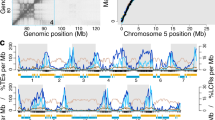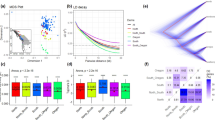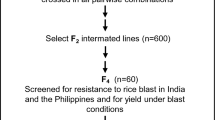Abstract
Genetic variation was examined at 21 allozyme loci in 11 populations of Eichhornia paniculata (Pontederiaceae) from N.E. Brazil and Jamaica. Populations from Jamaica are genetically depauperate with respect to electrophoretically detectable variation, containing a significantly lower number of polymorphic loci, alleles per locus, mean observed heterozygosity and genetic diversity than Brazilian populations. These measures were significantly correlated with the outcrossing rate (t) of populations. The allozyme data were used to examine the patterns of genetic variation within and between populations by estimates of gene correlation and Nei's gene diversity statistics. Populations within both regions are highly differentiated from one another, with those from Jamaica more strongly so. Brazilian populations contain more variation than is distributed among populations, while the reverse pattern occurs among Jamaican populations. The genetic distance between Jamaican populations is less than between Brazilian populations as a result of the low overall variability on the island. It is proposed that the founding of populations on Jamaica by long-distance dispersal, genetic drift and high levels of self-fertilisation all contribute to reducing levels of genetic variation in Jamaican populations.
Similar content being viewed by others
Article PDF
References
Avise, J C, Smith, M H, Selander, R K, Lawlor, T E, and Ramsey, P R. 1974. Biochemical polymorphism and systematics in the genus Peromyscus, V: Insular and mainland species of the subgenus Hapolomyomys. Syst Zool, 23, 226–238.
Ayala, F J, Powell, J R, and Dobzhansky, T. 1971. Enzyme variability in the Drosophila willistoni group. II. Polymorphisms in continental and island populations of Drosophila willistoni. Proc Nat Acad Sci USA, 68, 2480–2483.
Baker, H G. 1955. Self-compatibility and establishment after “long-distance” dispersal. Evolution, 9, 347–348.
Barrett, S C H. 1979. The evolutionary breakdown of tristyly in Eichhornia crassipes (Mart.) Solms (Water Hyacinth). Evolution, 33, 449–510.
Barrett, S C H. 1985a. Floral trimorphism and monomorphism in continental and island populations of Eichhornia paniculata (Spreng.) Solms. (Pontederiaceae). Biol J Linn Soc, 25, 41–60.
Barrett, S C H. 1985b. Ecological genetics of breakdown in tristyly. In Haeck, J. and J. W. Woldendorp (eds.) Structure and Functioning of Plant Populations 2: Phenotypic and Genotypic Variation in Plant Populations. North-Holland Publishing Company, Amsterdam, pp. 267–275.
Barrett, S C H, Brown, A H D, and Shore, J S. 1987. Disassortative mating in tristylous Eichhornia paniculata (Pontederiaceae). Heredity, 58, 49–55.
Bosbach, K, and Hurka, H. 1981. Biosystematic studies on Capsella bursapastoris (Brassicaceae): Enzyme polymorphism in natural populations. Plant Syst and Evol 137, 73–94.
Brown, A H D. 1979. Enzyme polymorphism in plant populations. Theor Pop Biol, 15, 1–42.
Brown, A H D, and Marshall, D R. 1981. Evolutionary changes accompanying colonization in plants. In Scudder, G. C. E. and Reveal, J. L. (Eds.) Evolution Today. Carnegie-Mellon University, Pittsburgh, pp. 351–363.
Brown, C R, and Jain, S K. 1979. Reproductive system and pattern of genetic variation in two Limnanthes species. Theor and Appl Genet, 54, 181–190.
Cardy, B J, Stuber, C W, and Goodman, M M. 1981. Techniques for starch gel electrophoresis of enzymes from maize (Zea mays L.). Institute of Statistics Mimeograph Series No. 1317, North Carolina State University, Raleigh, 31 pp.
Carlquist, S. 1974. Island Biology. Columbia Press, New York.
Clarke, C A, and Sheppard, P M. 1963. Interactions between major genes and polygenes in the determination of the mimetic patterns of Papilio dardanus. Evolution, 17, 404–413.
Cockerham, C C. 1969. Variance of gene frequencies. Evolution, 23, 72–84.
Cockerham, C C. 1973. Analysis of gene frequencies. Genetics, 74, 679–700.
Darlington, P J. Jr. 1957. Zoogeography. John Wiley and Sons, New York.
Dietz, E J. 1983. Permutation tests for association between two distance matrices. Syst Zool, 32, 21–26.
Dobzhansky, T. 1957. Genetics of natural populations. XXVI Chromosome variability in island and continental populations of Drosophila willistoni from Central America and the West Indies. Evolution, 11, 280–293.
Ganders, F R, Denny, S E, and Tsai, D. 1985. Breeding systems and genetic variation in Amsinckia spectabilis (Boraginaceae). Can J Bot, 66, 533–538.
Glover, D E. 1985. Mating systems and genetic variation in continental and island populations of Eichhornia paniculata (Spreng.) Solms (Pontederiaceae). M.Sc. Thesis, University of Toronto.
Glover, D E, and Barrett, S C H. 1986. Variation in the mating system of Eichhornia paniculata (Spreng.) Solms (Pontederiaceae). Evolution, 40, 1122–1131.
Gottlieb, L D. 1973. Enzyme differentiation and phylogeny in Clarkia franciscana, C. rubicunda and C. amoena. Evolution, 27, 205–214.
Gottlieb, L D. 1981. Electrophoretic evidence and plant populations. Prog, in Phytochemistry, 7, 1–46.
Guries, R P, and Ledig, F T. 1982. Genetic diversity and population structure in pitch pine (Pinus rigida Mill.). Evolution, 36, 387–402.
Harding, J, and Mankinen, C B. 1978. Genetics of Lupinus IV. Colonization and genetic variability in Lupinus suc-culentus. Theor Appl Genet, 42, 267–271.
Hamrick, J L, Linhart, Y B, and Mitton, J B. 1979. Relationships between life history characters and elec-trophoretically detectable genetic variation in plants. Ann Rev Ecol Syst, 10, 173–200.
Jain, S K. 1976. The evolution of inbreeding in plants. Ann Rev Ecol Syst, 7, 469–495.
Jain, S K, and Martins, P S. 1979. Ecological genetics of the colonizing ability of rose clover (Trifolium hirtum All.). Amer J Bot, 66, 361–366.
Lack, D. 1976. Darwin's Finches. Cambridge University Press, Cambridge.
Layton, C R, and Ganders, F R. 1984. The genetic consequences of contrasting breeding systems in Plectritis (Valerianaceae). Evolution, 38, 1308–1325.
Levin, D A. 1977. The organization of genetic variability in Phlox drummondii. Evolution, 38, 477–494.
Levin, D A. 1978. Genetic variation in annual Phlox: Self-compatible versus self-incompatible species. Evolution, 32, 245–263.
Loveless, M D, and Hamrick, J L. 1984. Ecological determinants of genetic structure in plant populations. Ann Rev Ecol Syst, 15, 65–95.
Macarthur, R H, and Wilson, E O. 1967. The Theory of Island Biogeography. Princeton University Press, Princeton.
Miller, R G. 1974. The jackknife-a review. Biometrika, 61, 1–15.
Mitton, J B, Linhart, Y B, Hamrick, J L, and Beckman, J S. 1977. Observations on the genetic structure and mating system of ponderosa pine in the Colorado front range. Theor Appl Genet, 51, 5–13.
Nei, M. 1972. Genetic distance between populations. Amer Natur, 106, 283–292.
Nei, M. 1973. Analysis of gene diversity in subdivided populations. Proc Nat Acad Sci, 70, 3321–3323.
Nei, M, and Roychoudhury, A K. 1974. Sampling variances of heterozygosity and genetic distance. Genetics, 76, 379–390.
Nei, M, Maruyama, T, and Chakraborty, R. 1975. The bottleneck effect and genetic variability in populations. Evolution, 29, 1–10.
Price, S C, and Jain, S K. 1981. Are inbreeders better colonizers? Oecologia, 49, 283–286.
Rick, C M, and Fobes, J F. 1975. Allozymes of Galapagos tomatoes: Polymorphism, geographic distribution and affinities. Evolution, 29, 443–457.
Rick, C M, Fobes, J F, and Holle, M. 1977. Genetic variation in Lycopersicon pimpinellifolium : evidence of evolutionary change in mating systems. Pl Syst Evol, 127, 139–170.
Rick, C M, Fobes, J F, and Tanksley, S D. 1979. Evolution of mating systems in Lycopersicon hirsutum as deduced from genetic variation in electrophoretic and morphological characters. Pl Syst Evol, 132, 279–298.
Scandalios, J G. 1969. Genetic control of molecular forms of isozymes in plants-a review. Biochem Genet, 3, 37–39.
Schoen, D J. 1982. Genetic variation and the breeding system of Gilia achilleifolia. Evolution, 36, 361–370.
Schwaegerle, K E, and Schaal, B A. 1979. Genetic variability and founder effect in the pitcher plant Sarracenia purpurea L. Evolution, 33, 1210–1218.
Shaw, C R, and Prasad, R. 1970. Starch gel electrophoresis of enzymes-A compilation of recipes. Biochem Genet, 3, 207–320.
Vallejos, C E. 1983. Enzyme activity staining. In Tanksley, S. D. and Orton, T. J. (Eds.) Isozymes in Plant Genetics and Breeding Part A. Elsevier Science Publishers, B.V. Amsterdam, pp. 469–515.
Weir, B S, and Cockerham, C C. 1984. Estimating F-statis-tics for the analysis of population structure. Evolution, 38, 1358–1370.
Williamson, M. 1981. Island Populations. Oxford University Press, Oxford.
Wright, S. 1951. The genetical structure of populations. Ann Eugen, 15, 313–354.
Yeh, F C, and Layton, C R. 1979. The organization of genetic variability in central and marginal populations of lodgepole pine Pinus contorta spp. Latifolia Can J Genet Cytol, 11, 487–503.
Author information
Authors and Affiliations
Rights and permissions
About this article
Cite this article
Glover, D., Barrett, S. Genetic variation in continental and island populations of Eichhornia paniculata (Pontederiaceae). Heredity 59, 7–17 (1987). https://doi.org/10.1038/hdy.1987.91
Received:
Issue date:
DOI: https://doi.org/10.1038/hdy.1987.91
This article is cited by
-
Genetic Diversity Within and among Disjunct Populations of the Mediterranean Island Endemic Delphinium pictum and D. requienii (Ranunculaceae)
Folia Geobotanica (2009)
-
Colonisation as a common denominator in plant metapopulations and range expansions: effects on genetic diversity and sexual systems
Landscape Ecology (2006)
-
Legitimate pollination of the tristylous flowers ofEichhornia azurea (Pontederiaceae) byAncyloscelis gigas bees (Anthophoridae, Apoidea)
Plant Systematics and Evolution (2000)
-
Do island populations have less genetic variation than mainland populations?
Heredity (1997)
-
The successful founder: genetics of introduced Carduelis chloris (greenfinch) populations in New Zealand
Heredity (1996)



